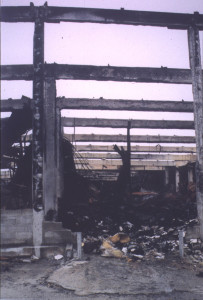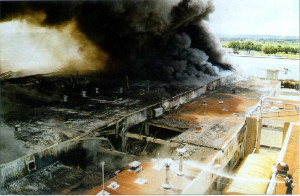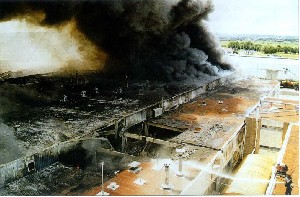A catering facility (handling 35 tonnes/day), in the process of obtaining administrative authorisations, ignited (due to flames or a short circuit?) around 1:10 pm at the periphery of an industrial zone. 4,000 m² were destroyed within 17 min, followed by another 15,000 m² of building space and refrigeration units (containing F22 refrigerant) within 2 hours, despite the quick emergency response (7 min after the alarm sounded) that deployed considerable hydraulic resources (including 13 large hose nozzles and 3 smaller ones). A firewall protected the site’s administrative premises. Both the magnitude and speed of this conflagration, followed by fears over toxic emissions, complicated relief efforts. A thick smoke made it harder to locate the fire sources, yet the refrigerants (glycol water, R22) were found to exert no influence. The fire extinction water (max. 450 m3/h) ran off into a stormwater overflow basin following melting of the PVC stormwater downpipe. The fire was controlled around 3:50 pm, with the announcement of complete extinction at 8 am the next morning.
The body of an asphyxiated subcontracted welder was later found in a hallway, and the remains of 2 employees were identified on the mezzanine above the cold storage rooms; 8 employees sustained injuries. Court-mandated expert appraisals slowed the clearing of debris, and 500 tonnes of meat had to be removed from the rubble within a few days. Nauseating odours were noticeable 1 km from the accident site (businesses and residential buildings 500 m away). Total damage was assessed at 61 million francs; 110 of the caterer’s 140 employees were made redundant. The site, which had already experienced 2 smaller fires, would close definitively a year later.
The rapid propagation of this fire, coupled with difficulties during emergency response, offered a number of lessons: delayed notification (18) due to the absence of a sound alarm; late discovery of the incident (lunch break, smoke alerting neighbours); and inappropriate means of communication (a phone line on the premises without access to the public network, switchboard closed). The type of construction, with two interconnected frames (sandwich panels / cladding and roofs) and no smoke vent, causing confinement of heat and radiation in the double-wall enclosure, prevented the exhaust of hot gasses. A nonexistent / insufficient partitioning and heavy reliance on polyurethane foam (M1 or M2?) for wall/ceiling panels, whose resistance was limited to 300°C, raised the thermal load in generating hazardous gasses and volatile matter, thus fanning flames that were spreading “like blowtorches through the walls”. Other exacerbating factors included: the collapse of structural metal components due to fire, molten roof bitumen (from a steel panel tank) that poured and burned, suspended ceilings complicating access to large isolated areas under the roof, and high-capacity freezing chambers. The thermal loads varied considerably (e.g. conditioning ma
Download the detailed report in .pdf format (192 Kb)






